⚡️ 1-Minute DISCO Download
The "AI gap" is the disconnect between how legal professionals and clients view artificial intelligence. Bridge it by proactively addressing misconceptions and focusing on clear benefits like speed, efficiency, and better outcomes.
📊 Key Stat
59% of corporate legal clients say they want their outside counsel to use generative AI.
🌊 Dive Deeper
Need to explain AI without technical jargon? Check out the section on "Translating Complexity into Clarity." It offers simple ways to describe common AI use cases, focusing on client benefits instead of complex features.
Your clients already know about AI. They're learning its capabilities, experimenting, and wondering how it fits into their legal strategy. That means, ready or not, the conversation is coming your way.
But here’s the challenge: while you’re integrating legal AI tools into your work, many clients are still unsure of whether to be excited, concerned, or both.
We call this “the AI gap” – the disconnect between legal professionals' understanding of AI and their clients' perceptions or concerns about AI.
This article is your guide to bridging that gap.
Whether you're reactively fielding client questions about generative AI or proactively bringing it into the conversation, I’ll equip you with the tools to navigate these
discussions with confidence. You'll learn how to demystify the technology, highlight its strategic value, and address sensitive topics like data privacy, accuracy, and ethics.
I’ll walk you through the following key elements of client conversations about AI:
- Understanding misconceptions
- Initiating the conversation
- Providing clarity by using real-world examples
- Building trust by demonstrating value
- Continuous communication and improvement
Ready to meet your clients where they are and help lead them forward? Let’s dive in.
Prefer video? Watch this in webinar format on demand: Bridging the AI Gap: How to Talk to Clients About Emerging Legal Technologies 🎬
The crucial "AI gap": Understanding client perspectives
Before you can guide clients through the benefits of AI, it’s important to understand what they’re really thinking. Many clients are curious but cautious. Some worry AI will replace legal professionals. Others assume AI is infallible – and more than a few feel overwhelmed.
By understanding these concerns, addressing them openly, and correcting misconceptions, you can position yourself as a trusted advisor in this rapidly evolving space.
Understanding and addressing misconceptions
Before you can guide clients toward the strategic benefits of AI, you need to step into their shoes.
Many clients are navigating a flood of information — and sometimes, misinformation — and they’re looking to you for clarity. What they often bring to the conversation is a mix of valid concerns, outdated assumptions, and gut-level discomfort.
These misconceptions tend to fall into three categories:
- Fear of replacement by AI, and loss of control
- Trust and safety concerns
- Adoption anxiety
Knowing how to address each one will prepare you to lead confident, informed conversations.
1. Fear of replacement by AI, and loss of control
AI can feel threatening. Clients fear being left behind — or worse, left out of the loop — by a technology they don’t fully understand.
😟 Misconception: “AI will replace lawyers.”
This fear taps into the headlines: Automation is coming for professional jobs. Clients may wonder if AI will replace their trusted counsel or if they're paying for work a machine is doing. It challenges the value proposition of legal services and creates anxiety about losing the human touch.
Here’s how to respond: Reframe AI as assistive, not autonomous. Let clients know that AI isn’t replacing lawyers. It’s helping them move faster, see more, and catch what might otherwise be missed.
Try saying:
“Think of this like your lawyer with superpowers.”
or
“One of AI’s greatest strengths is data analysis, so we use it to help us find key documents and patterns faster.”
⬛ Misconception: “AI is a black box.”
This refers to the lack of transparency in how some AI systems generate answers, especially earlier tools that didn’t cite sources or explain their reasoning.
Clients don’t like the idea of mystery, especially when it’s tied to litigation or liability. If they don’t understand how AI arrives at its conclusions, they may assume the worst: that the results are arbitrary, inaccurate, or untrustworthy.
Here’s how to respond: Pull back the curtain. If a client is nervous about the black box effect, show them how the tools work. You don’t need to go deep into the tech stack. Just explain in plain terms what the AI is doing and how it gets verified.
Try saying:
“We use AI to identify likely relevant documents. But before anything goes into a motion or a production, it’s reviewed and validated by our team.”
Related read: How to Use Generative AI for Fact Analysis and Investigation
😵💫 Misconception: “AI will hallucinate and give me wrong answers.”
Your clients have heard the stories: made-up case citations, factual errors, decisions that can’t be replicated. They worry about relying on something that isn’t consistent or accountable, especially when the stakes are high.
Here’s how to respond: Be up-front about risk, then show the controls. Acknowledge the possibility of hallucinations and AI error. Then, explain your oversight process. Clients respect transparency and want to know you’re not blindly trusting the output either.
Try saying:
“Just like junior associates, AI needs supervision. We’ve put safeguards in place to make sure everything is accurate before it reaches your desk.”
2. Trust and safety concerns
For many clients, AI introduces uncertainty around ethics, data privacy, and bias, areas where legal teams are expected to lead with integrity.
👀 Misconception: “Using AI means sacrificing privacy or confidentiality.”
There’s concern that sensitive case information will be exposed, either through integrations with third-party tools or by being used to train external models.
How to respond: Lead with your due diligence. Clients want to know that you’ve done the legwork. Be prepared to speak confidently about the software or vendors you use, the data protections in place, and how you ensure ethical compliance.
Try saying:
“We only use tools that align with our ethical obligations and industry best practices. Data is never used to train public models, and we verify outputs to ensure accuracy and fairness.”
😶Misconception: “Our inherent biases will be baked into AI.”
Clients understand that technology reflects its inputs. They worry that hidden bias could influence legal strategy, discovery decisions, or case outcomes, especially if the training data is opaque.
How to respond: Shift the conversation from fear to governance. Don’t treat these concerns as irrational. Treat them as legitimate risk factors you’ve already considered.
Try saying:
“These are exactly the questions we asked when selecting our tools. We’ve put policies in place to ensure security, privacy, and human oversight at every step.”
🌎Misconception: “We don’t know how AI fits into the rules of ethics – so it doesn’t.”
For some, the uncertainty isn’t about what the tool does. It’s about whether using it could expose them to professional risk. Without clear regulatory guidance, clients may default to caution.
How to respond: Make the ethical commitment explicit. It helps to address this aloud: Your firm isn’t experimenting with a client’s case. You’re using AI in a responsible, well-governed way.
Try saying:
“Our policy is that AI supports but never replaces our legal judgment. You’re always getting attorney-reviewed work product.”
3. Adoption anxiety
Even clients who are interested in AI often feel overwhelmed. They worry that it’s too complex, too costly, or simply out of reach.
💰Misconception: “AI is too expensive for my case.”
Many clients assume AI is only for enterprise-level litigation. They associate it with premium costs, custom development, or high-stakes scenarios.
How to respond: Start with their pain points, not the product. Don’t pitch AI. Solve a problem. Clients may not care about your tools, but they care deeply about speed, efficiency, and cost.
Try saying:
“You mentioned tight timelines on this case. We’re using technology that lets us summarize a 100-page depo in five minutes, and surface hot documents in hours, not days.”
😫Misconception: “I don’t know where to start.”
Some clients have been told to “look into GenAI” by their GC or CIO, but they don’t know what that means in practice. Others are curious but paralyzed by the volume of options and unknowns.
How to respond: Demystify the entry point. Reassure them that AI doesn’t require a full transformation and that you’re actively guiding the process.
Try saying:
“You don’t need to learn a new system. Our team handles everything on the backend. We just use smarter tools to work faster and more accurately.”
📉Misconception: “AI cuts corners or lowers quality.”
Some clients associate AI with shortcuts or worry that automation means less attention to detail. They want to feel confident that strategic thinking and personalization aren’t being lost to technology.
How to respond: Position AI as a value enhancer. Clients want confidence that their legal team is operating at peak performance. When you talk about AI, emphasize how it enhances your ability to move faster, uncover more relevant information, and reduce risk.
Try saying:
“It’s not about replacing people or cutting corners. We’re using AI to elevate our game so we can act faster, surface stronger insights, and ultimately give you the best possible outcome.”
Initiating the AI conversation
Here’s what might surprise you: 59% of corporate legal clients say they want their outside counsel to use generative AI. They’re not waiting for you to play defense. They’re looking for you to lead.
Still, many attorneys hesitate to bring it up. AI is new. It’s technical. And in a client conversation, it can feel like you’re stepping into risky terrain. What if they push back? What if you can’t answer every question? What if you sound like you're selling a tool instead of building trust?
That hesitation is understandable. But staying silent sends a signal too, and it may not be the one you intend.
This isn’t about pitching AI. It’s about showing your clients that you're thoughtful, strategic, and ready to guide them through the next era of legal work. Here’s how to start the conversation with confidence.
1. Lead with education, not assumption
Don’t wait for your client to bring up AI, and don’t assume they don’t want to talk about it. In many cases, they’re waiting for you to open the door. They know it’s being integrated into most business practices, but they don’t know how it applies to their matters. To set them at ease, be proactive. Speak to the role AI plays in your workflow.
Try saying:
“You may have heard a lot about generative AI in legal lately. We’ve been using it in a very controlled, human-supervised way to help us move faster and work smarter. Would it be helpful for me to explain how it fits into our process?”
This simple, open-ended offer invites curiosity without pressure. It signals confidence. And it lets the client decide how deep they want to go.
Need help developing your AI workflows? Get our on-demand training: AI Predictive Workflows.
2. Position AI as a strategic advantage
Instead of framing AI as a tool you use behind the scenes, frame it as evidence of your team’s leadership, a way you help clients stay ahead of change. Many in-house teams are under pressure to be “AI-ready,” and they’re looking to outside counsel to demonstrate what that actually looks like.
Try saying:
“A lot of legal departments are being asked how they’re using AI in their workflows. One of the ways we help is by identifying where it adds real value, like speeding up fact analysis, helping us surface key documents faster, and reducing the number of files that need full manual review. That’s something we’re already doing for this case.”
Now, you’re helping your client lead the charge, without the burden of figuring it all out themselves.
3. Reassure around control and oversight right away
If you’re speaking to clients about AI for the first time, do it in the same breath as explaining your guardrails. Clients want to know that nothing is automated without oversight and recommendations are vetted by human judgment.
Try saying:
“We use AI to help us move faster, but not without human oversight. We treat AI’s output like we would any junior associate’s work.”
This reassurance builds trust and signals that you’re not experimenting on their case. You’re using mature, responsible processes.
4. Anchor the conversation in client outcomes, not the technology
Even the most tech-curious clients don’t care about product specs. They care about what they get from working with you: faster results, better strategy, fewer surprises. Start there. Then show how AI helps make it happen.
Try saying:
“Our goal is to get you answers faster and avoid unnecessary review cycles. Our AI tools help us focus on what matters, so we can spend more time on strategy and less on logistics.”
This reinforces the value you bring through AI. That’s a conversation clients are ready to have.
5. Make it a value conversation, not a tech conversation
Don’t position AI as the latest trend. Present it as a way to deliver stronger outcomes. Some clients will ask about ROI. Others just want to know they’re not paying for fluff. Either way, your message should be clear: They’re paying for judgment, not just process.
Try saying:
“AI helps us work more efficiently, which means we spend more of our time on strategy, insight, and execution and less on repetitive manual tasks.”
Translating complexity into clarity with real-world examples
Most clients don’t want a technical breakdown of how AI works. What they want is clarity:
- What is this tool doing?
- How does it impact their matter?
- Why should they trust it?
The best way to bridge that gap is to focus on tasks they already understand and explain how AI executes them faster, smarter, or with fewer surprises. For example, here are four of the most common AI use cases in legal practice, with guidance on how to explain each one clearly and confidently.
Example 1: Document Review and Tagging
What AI does:
- Rapidly processes large volumes of case documents
- Suggests relevance-based tags
- Surfaces key material for attorney review
How to explain it to clients:
“In a typical case, we might review tens or even hundreds of thousands of documents. We use technology that helps us prioritize and tag those documents faster, so we can focus on what’s truly relevant and get to the strategy sooner.”
This is one of the most powerful use cases to reduce cost, compress timelines, and avoid discovery delays.
Tip: DISCO’s Auto Review can complete a first-pass review in hours, with 10-20% higher precision and recall than human reviewers.
Example 2: Summarizing Deposition Testimony
What AI does:
- Generates structured summaries of long transcripts in minutes
- Highlights key testimony and points of interest
How to explain it to clients:
“Summarizing a full deposition transcript can take half a day or more. We use a tool that gives us a clean summary in minutes. That lets us move quickly while staying focused on the facts that matter most to your case.”
This is a great early conversation point, and it illustrates perfectly how AI enhances what lawyers already do.
Tip: Cecilia Deposition Summaries can generate a chronological and key-topic summary of a recorded deposition in a single click. It pairs perfectly with Cecilia Q&A, which empowers you to ask critical questions about your case and get cited, linked answers in minutes.
Example 3: Drafting Timelines or Case Chronologies
What AI does:
- Identifies key dates, events, and facts across a dataset
- Organizes them into a usable chronology
How to explain it to clients:
“When we need to piece together a timeline — what happened, when, and who was involved — we use technology that helps us generate a comprehensive, citation-backed case chronology in minutes, a process that would take hours or even days if we did it manually.”
This use case is easy to explain and demonstrates how AI can support organization and accuracy without taking over decision-making.
Tip: DISCO Timelines automatically generates a detailed, citation-backed chronology from your case documents — no manual extraction required. Instead of spending hours pulling dates and facts from hundreds of pages, you get an organized, interactive timeline in minutes. It’s fast, accurate, and built to give you a strategic head start.
Example 4: Answering Specific Questions Within a Document Set
What AI does:
- Allows attorneys to query a set of documents (“When was X first mentioned?” or “Who communicated with Y?”)
- Provides direct answers with citations
How to explain it to clients:
“We can now ask very specific questions within the case documents — like, ‘When did this issue first come up?’ — and get a focused response with source material to back it up. That saves time and helps us quickly zero in on the facts that matter most.”
This shows that AI isn’t just about speed. It’s about precision and giving clients more confidence in the completeness of your review.
Tip: Cecilia Q&A lets you ask plain-language questions about your document set — just like you would a colleague — and get fast, accurate answers with sources cited and linked. Instead of keyword searching or reviewing documents manually, you can zero in on facts, timelines, or inconsistencies in seconds. It’s like having an AI-powered research assistant built into your case file.
Building trust and demonstrating value
Once the AI conversation has started, clients often want to go deeper. They want to know not just how the tool works, but what it means for outcomes, privacy, ethics, and risk.
These aren’t objections. They’re opportunities. Thoughtfully answering these questions helps build credibility and strengthen the relationship. Here are three key areas to reinforce client trust, with sample language you can adapt to your own voice.
Demonstrating tangible value: time, cost, and strategy
Clients don’t want to pay for inefficient busywork. It can reassure them to understand that AI allows you to focus where it matters most: on strategy and outcomes.
You don’t need to make sweeping claims. Just show how AI helps you and your team deliver more value for the same — or less — investment.
Client-ready framing:
“We use AI to help us move faster. That means you get better strategic input from our team earlier, giving you the competitive edge.”
And to preempt concerns about replacement:
“This isn’t about cutting people. It’s about freeing our attorneys to spend more time on high-value, judgment-driven work. AI supports that work, but it doesn’t replace it.”
AI by the numbers:
- 5 minutes: Speed at which DISCO’s Deposition Summaries can summarize 100 pages.
- 2.5 minutes: Time it takes DISCO’s Auto Timelines to produce a case chronology from a complaint.
- 32,000: Number of documents Auto Review can process per hour, the equivalent of a 640-person review team working at industry-standard speeds.
- 85%: Percentage of native ingests in DISCO can be completed in less than 30 minutes.
- 87%: Time saved in fact investigation using Cecilia Q&A
Navigating ethical concerns: boundaries, bias, and accountability
Ethics questions may start as vague discomfort, but they often boil down to these three things:
- Are you protecting our sensitive information?
- Is the AI introducing hidden risks?
- How do you stay accountable?
It’s important for clients to understand that you have strict guardrails in place to protect their interests.
Try saying:
“When we use AI, we never input sensitive facts or client-identifying information. We use it in a controlled way to explore case theory or surface insights, always respecting client confidentiality.”
For bias and accountability:
- Emphasize that AI is never used to make final decisions.
- Highlight the importance of human judgment as the filter for any AI insight.
- Mention the importance of testing and validation where appropriate to ensure outputs make sense in legal context.
Try saying:
“AI doesn’t make legal decisions for us. It helps us widen our lens, but everything is checked and validated by our attorneys. If an AI-generated insight doesn’t hold up under scrutiny, we don’t use it.”
And you can confidently point to firm-wide responsibility:
“Our firm is committed to responsible AI use and has developed strict internal guidelines about when and how it can be used. It’s always with attorney supervision and client confidentiality as the top priority.”
Related on-demand webinar: How to Build an AI Policy That Minimizes Risk and Maximizes Potential 🎬
Addressing data privacy & security:
Clients want assurance that their data won’t end up in a public model or in the wrong hands. It’s important to give them clear and compelling language they can repeat to their GC, CIO, or board.
Try saying:
“We never input sensitive or identifying case data into public AI tools.”
And to back that up:
“We’ve done the due diligence on every tool we use. That includes robust data security protocols, compliance with legal regulations, and ethical guidelines to ensure we’re protecting your information at every step.”
If the client wants more:
“We’re happy to walk you through how we evaluate and govern AI use internally. You should feel confident in not just what we do, but how we’re do it.”
Post-launch & continuous improvement: Strengthening client relationships
AI isn't a one-and-done conversation. As your use of technology evolves, so do client expectations and questions. The firms that lead in this space introduce AI thoughtfully — and revisit the conversation as needed — to reinforce its value and show how it improves client outcomes over time.
In this final section, we’ll explore how to:
- Reaffirm the irreplaceable role of human expertise
- Set realistic expectations around what AI can and can’t do
- And use your AI maturity to deepen client trust and collaboration
Let’s look at how to keep the relationship strong, strategic, and forward-looking.
Reinforce the role of human judgment and expertise
Once you’ve opened the AI conversation with clients, it’s time to demonstrate the value you’ve promised. Let them see that human judgment still leads the process.
Clients will feel reassured when they observe:
- Clear, well-reasoned decisions
- Strategy that evolves as the matter develops
- Responsiveness to new facts or shifts in direction
- A legal approach that feels tailored, not templated
Over time, that’s what reinforces trust in AI: Evidence that AI only does the grunt work while you are doing the higher level strategy that clients value most:
- Weighing competing risks in light of business realities
- Interpreting tone, motivation, or credibility
- Reading between the lines of testimony or negotiation
- Leading with empathy in high-stakes conversations
These are distinctly human strengths that remain at the core of every strong attorney-client relationship. Over time, this blend of efficiency and expert insight will reinforce not just trust in your work, but in your leadership.
If concerns do come up, especially around hallucinations or accuracy, you can simply point to your internal safeguards:
“We know AI can get things wrong. That’s why we’ve built in validation steps before anything is used in your case.”
But in most cases, the best reassurance is visible progress. Strategy and nuance speak louder than disclaimers.
Manage expectations about AI
Even when clients are excited about your use of AI, it’s important to stay grounded in what the technology can and can’t deliver. Overpromising undermines trust. The best way to build credibility over time is to be honest, measured, and clear about how you’re using AI and why it benefits the client.
Here are a few simple strategies to help you set and maintain realistic expectations:
Related read: How to Use Generative AI for Fact Analysis and Investigation in 2025
Be honest about its limits
Clients may assume AI produces perfect results. Remind them that, like any assistant or tool, it still requires oversight.
“AI isn’t perfect, but DISCO’s platform is designed to reduce noise and surface what matters, helping us start from a better baseline. Of course, we still validate everything before it becomes part of your case strategy. That’s how we balance speed with sound judgment.”
This acknowledges real risks without undermining the value of the tool.
Learn more about Cecilia, our GenAI legal software suite for litigation teams.
Set clear boundaries for where AI won’t be used
Reassure clients that strategic thinking and legal analysis remain entirely human.
“We don’t use AI for anything that requires legal interpretation. We refine and verify language in written motions, applying precedent, or making strategic calls. That’s work only a lawyer should do, and that’s how we treat it.”
Boundaries show that you’re being intentional with your use of technology.
For example, with just five days until fact discovery deadline, this firm’s client uncovered 25,000 additional documents requiring immediate review. Read the full story.
Talk about process, not products
Focus on the downstream results — what the AI platform’s efficiencies make possible in terms of review speed and outcomes.
For example:
“With DISCO, we’re able to conduct fact investigations nearly 90% faster than with traditional workflows. That lets us move past the initial work quickly and focus on the legal thinking that drives results.”
You could close with:
“For our clients, that means tighter timelines, more strategic input, and fewer surprises.”
Related read: How AI Is Transforming Dispute Resolution
Revisit expectations if the technology evolves
As your toolset changes, make sure your clients understand what’s new and how it fits into their case. Surprises — especially around AI — can erode trust.
For example, you might say:
“DISCO rolled out a new capability, and here’s how we’re using it to serve you better — without losing control…”
When you approach AI use with honesty, humility, and clear communication, you build a reputation not just for innovation, but for integrity. And that’s what turns first-time clients into long-term partners.
Stay up-to-date on DISCO innovations that unlock new levels of speed and productivity.
AI as a relationship builder
By now, your clients understand that you’re using AI, and they know you’re using it responsibly. The opportunity going forward is to show the long-term benefits of your team’s expertise with these tools.
Clients don’t need to see a flashy technology stack. They care more about how you integrate AI, adapt to change, and keep them informed without overwhelming them. They want to know that you:
- Stay ahead of the curve, but don’t chase shiny objects
- Proactively communicate, rather than waiting for questions
- Continue improving, especially in the face of complexity or change
When you talk with them about AI, aim to build trust, transparency, and consistency. Speak clearly about what you use, why you use it, and how it improves outcomes, For example:
“We’re always looking for ways to improve how we work, and that includes using AI to make sure we’re delivering the best possible value.”
Conclusion
If you’ve been waiting to have the AI conversation with your clients, now is the time to start. The technology is evolving quickly, and it’s already shaping how legal work gets done.
Your clients know this. Many are already using AI in their own organizations. Others are still unsure what it means for them. Either way, they’re looking to you for clarity. They’re eager to understand the technology and how you plan to use it responsibly, strategically, and in their best interest.
This article has walked you through how to:
- Start the conversation with confidence
- Address concerns with clarity and reassurance
- Translate complex capabilities into clear client benefits
- Demonstrate thoughtful, well-governed use of AI
By leading these conversations, educating your clients, and answering their questions openly and honestly, you lay the groundwork for stronger, more collaborative client relationships. It also allows you to shape how clients think about legal technology and define success.
Bridging the AI gap is no longer optional. It’s a critical step toward modernizing your practice and positioning your firm as a forward-thinking partner. More than that, it’s an ongoing opportunity to demonstrate that your value extends beyond legal insight to include smart, future-ready judgment.
That’s what sets top-performing firms apart — not just today, but in the years ahead.
Ready to take the next step?
Watch the webinar: Bridging the AI Gap. Gain practical strategies for discussing AI-powered workflows with clients, building trust, and managing expectations.
Let DISCO's state-of-the-art AI platform transform your practice. Learn more about Cecilia AI, the leading legal software suite for litigation teams.
See DISCO in action. Schedule a demo and learn how DISCO's technology can support your firm's unique needs and help you stay ahead in a rapidly evolving legal landscape.






%20(1).jpeg)







.png)
